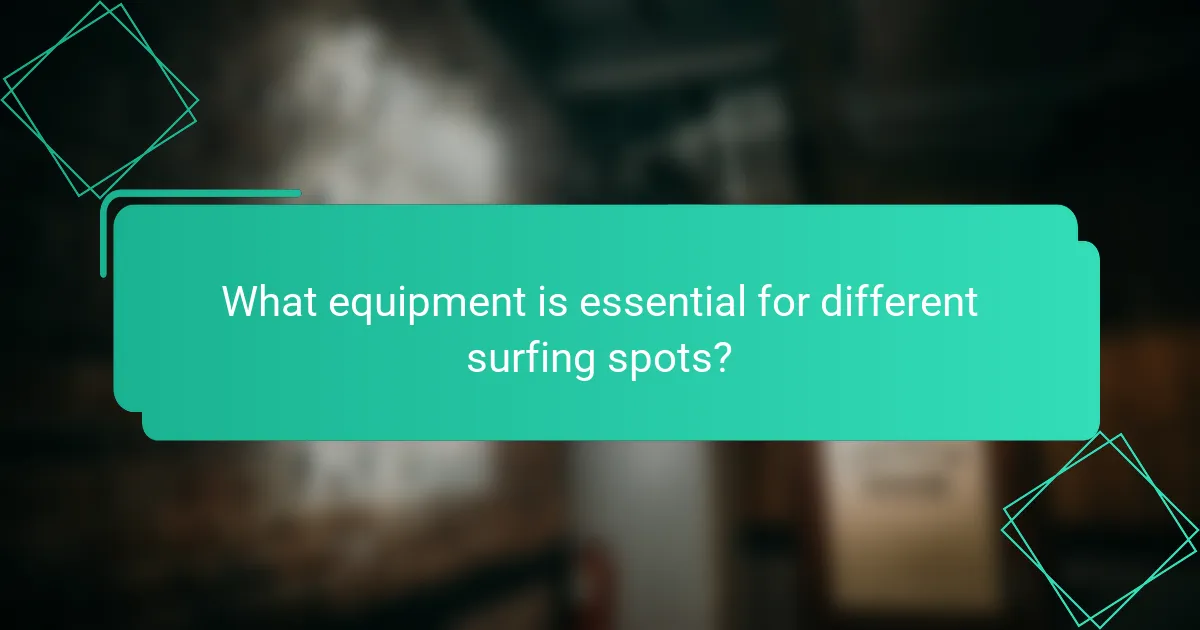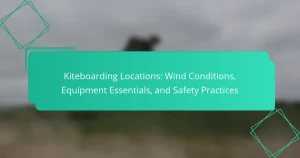Choosing the right surfing spot is crucial for maximising your experience on the waves. This article explores various wave types found at top locations, examines seasonal conditions that affect surf quality, and outlines essential equipment needed for different environments. Understanding these factors will help surfers of all levels make informed decisions for optimal performance and enjoyment.

Which surfing spots offer the best wave types?
Top surfing spots for wave types include Jeffreys Bay, known for its long right-hand point breaks; Pipeline in Hawaii, famous for powerful barrels; and Trestles in California, ideal for high-performance surfing. Each location offers unique wave characteristics influenced by seasonal conditions. For example, Jeffreys Bay has consistent swells from April to September. Essential equipment varies by spot; a shortboard is optimal for Pipeline’s fast waves, while a funboard suits Trestles’ varied conditions.
What are the characteristics of beach breaks?
Beach breaks are characterised by waves breaking over sandy bottoms, making them ideal for surfers of all skill levels. These breaks often produce softer, more forgiving waves, especially during low tide. The wave shape can vary significantly, influenced by wind, swell direction, and tide levels. Beach breaks tend to be more consistent than reef breaks, providing reliable surf conditions throughout the year. Additionally, they can accommodate various surfboard types, including shortboards and longboards, enhancing versatility for surfers.
How do point breaks differ from reef breaks?
Point breaks feature waves breaking over a sandy bottom, while reef breaks occur over coral or rocky formations. Point breaks often provide longer rides and more predictable waves, making them ideal for various skill levels. Reef breaks can produce powerful, steep waves but may require more advanced skills due to their inherent dangers. Seasonal conditions also impact wave quality, with point breaks generally more consistent year-round compared to the often variable conditions of reef breaks.
What wave types are ideal for beginners?
Soft, rolling waves are ideal for beginners. These waves provide a gentle learning environment, allowing new surfers to practice balance and paddling without overwhelming force. Look for beach breaks with consistent, small swells typically found in beginner-friendly surf spots. Additionally, waves with a gradual sandy bottom reduce the risk of injury during falls.
Which advanced wave types challenge experienced surfers?
Experienced surfers face challenges from advanced wave types like reef breaks, point breaks, and heavy beach breaks. These waves often feature steep faces, powerful swells, and complex currents. For example, reef breaks can produce hollow waves that require precise timing and positioning. Heavy beach breaks can be unpredictable, with shifting sandbars affecting wave shape and size. Understanding these wave types enhances a surfer’s ability to navigate challenging conditions effectively.

How do seasonal conditions affect surfing spots?
Seasonal conditions significantly influence surfing spots by affecting wave types and surf quality. Different seasons bring variations in swell patterns, wind conditions, and water temperatures, which can enhance or diminish surfing experiences.
In winter, many locations experience larger swells due to storm activity, creating powerful waves ideal for experienced surfers. Conversely, summer typically brings smaller, more gentle waves, suitable for beginners. For instance, spots like Hawaii’s North Shore thrive in winter, while Southern California’s beaches are more favourable in summer.
Additionally, seasonal changes affect equipment needs. Cold water necessitates thicker wetsuits, while warmer months allow for lighter gear. Understanding these seasonal dynamics helps surfers choose the right locations and equipment for optimal performance.
What are the key factors in wave formation?
Wave formation is influenced by wind speed, wind duration, and fetch. These factors determine wave height, energy, and consistency. Wind speed affects how quickly waves build, while duration influences the energy transfer. Fetch, the distance wind travels over water, contributes to wave size. Understanding these elements is crucial for identifying optimal surfing conditions.
How does wind influence surf conditions?
Wind significantly influences surf conditions by affecting wave height, direction, and consistency. Strong offshore winds create cleaner, more organised waves, while onshore winds can lead to choppy conditions. Seasonal wind patterns also determine the best surfing times at various spots. For instance, trade winds often enhance surf quality in tropical regions during specific months. Understanding these dynamics helps surfers select optimal times and locations for their activities.
Which seasonal patterns are common in popular surfing destinations?
Popular surfing destinations exhibit distinct seasonal patterns that influence wave types and conditions. Locations like Hawaii see consistent swells from October to March, while summer months bring smaller waves. In California, winter storms generate powerful surf, while spring and summer offer more manageable conditions. Australia’s Gold Coast has reliable waves year-round, but peak season runs from March to May and September to November. Each destination’s unique climate and ocean currents contribute to its seasonal surfing experience.

What equipment is essential for different surfing spots?
Essential equipment varies by surfing spot, influenced by wave types and seasonal conditions. Different locations require specific gear to ensure safety and performance.
| Surfing Spot | Wave Type | Seasonal Conditions | Essential Equipment |
|———————–|——————-|——————————|——————————–|
| Beach Breaks | Powerful waves | Summer: consistent swells | Shortboard, leash, wetsuit |
| Reef Breaks | Steep, hollow waves| Winter: big swells | Shortboard, reef booties |
| Point Breaks | Long, peeling waves| Spring: moderate swells | Longboard, leash, wetsuit |
| River Mouths | River waves | Year-round: varying flows | Shortboard, life jacket |
| Big Wave Spots | Massive waves | Winter: extreme conditions | Gun board, impact vest |
| Soft Top Beaches | Gentle waves | Summer: family-friendly | Soft top board, rash guard |
How do surfboard types cater to various wave conditions?
Surfboard types are designed to perform optimally in specific wave conditions. Shortboards excel in steep, powerful waves, while longboards provide stability in smaller, slower waves. Fish boards are versatile for varying conditions, and funboards balance manoeuvrability and ease of use. Each type caters to unique attributes of wave height, speed, and shape, ensuring surfers can maximise their experience based on seasonal conditions.
What wetsuit specifications are necessary for varying climates?
A wetsuit’s specifications must match the climate and water temperature for effective surfing. In warmer climates, thinner wetsuits (1-2 mm) or shorties are suitable, while colder areas require thicker suits (4-5 mm) or drysuits.
| Climate Type | Wetsuit Thickness | Water Temperature Range |
|——————|——————-|————————–|
| Warm | 1-2 mm | 70°F and above |
| Mild | 3 mm | 60°F – 70°F |
| Cold | 4-5 mm | 50°F – 60°F |
| Frigid | 6 mm or drysuit | Below 50°F |
Which surf accessories enhance the surfing experience?
Surf accessories like leashes, wax, and board bags significantly enhance the surfing experience. A reliable leash prevents board loss, while wax improves grip. Board bags protect equipment during transport. Additionally, wetsuits provide thermal insulation, enabling longer sessions in colder waters. Fins enhance manoeuvrability and stability, tailored to wave types and conditions.

How can surfers prepare for specific surfing spots?
Surfers can prepare for specific surfing spots by researching wave types, seasonal conditions, and necessary equipment. Understanding the wave characteristics, such as height and power, helps in selecting the right board. Seasonal conditions, including wind patterns and tides, influence the best times to surf. Additionally, bringing appropriate gear, like wetsuits or leashes, ensures safety and comfort.
What local knowledge is vital for navigating unfamiliar breaks?
Local knowledge about wave types, seasonal conditions, and equipment needs is essential for safely navigating unfamiliar surf breaks. Understanding local wave patterns helps anticipate conditions. Seasonal insights inform the best times to surf, while knowledge of required equipment ensures preparedness for varying surf environments. Familiarity with local hazards, such as rocks or currents, is also critical for safety.
How do tide charts impact surfing conditions?
Tide charts significantly influence surfing conditions by determining wave height and frequency. Accurate tide data helps surfers identify optimal times for catching waves.
High tides can create larger, more powerful waves, while low tides may expose reefs and sandbars, altering wave shape. Seasonal variations also affect these conditions, as certain times of year may bring more consistent swells.
Surfers often rely on tide charts to plan sessions, ensuring they hit the water during prime conditions. Understanding local tide patterns can enhance the surfing experience and increase safety.
What safety precautions should surfers take at different spots?
Surfers should assess conditions and follow local guidelines at each spot. Key safety precautions include checking wave types, understanding currents, and using appropriate equipment.
1. Research local conditions before surfing.
2. Use a leash to prevent losing your board.
3. Wear a wetsuit or rash guard for protection.
4. Stay aware of other surfers to avoid collisions.
5. Know the emergency protocols for the area.

What are the common mistakes to avoid when selecting a surfing spot?
Common mistakes when selecting a surfing spot include ignoring wave types, neglecting seasonal conditions, and not considering equipment needs. Understanding these factors is crucial for a safe and enjoyable surfing experience.
1. Failing to assess wave types can lead to choosing spots unsuitable for your skill level.
2. Overlooking seasonal conditions may result in poor surfing conditions or dangerous situations.
3. Not matching equipment to the surf environment can hinder performance and safety.
4. Disregarding local knowledge, including tides and currents, can lead to unexpected challenges.
5. Ignoring crowd sizes can affect your surfing experience, especially for beginners.
How does overestimating skill level affect choice of waves?
Overestimating skill level can lead to poor wave selection, resulting in unsafe conditions. Surfers may choose waves that exceed their abilities, increasing the risk of injury and discouragement. This mismatch can also affect enjoyment and progression in surfing. Understanding personal limits and choosing appropriate waves enhances safety and skill development.
What are the pitfalls of ignoring local regulations?
Ignoring local regulations can lead to severe consequences for surfers. These pitfalls include legal penalties, safety risks, and environmental damage.
Legal penalties may involve fines or restrictions on access to popular surfing spots. Safety risks arise from inadequate knowledge of local hazards, such as strong currents or dangerous wildlife. Environmental damage can occur if surfers disregard protected areas, harming marine ecosystems.
Overall, understanding and adhering to local regulations ensures a safer and more sustainable surfing experience.
How can poor equipment choices ruin a surfing experience?
Poor equipment choices can significantly diminish a surfing experience. Using the wrong board type for specific wave conditions can lead to poor performance and safety risks. For example, a shortboard may not provide enough stability in choppy waters, while a longboard might be unwieldy in powerful surf. Additionally, inadequate wetsuits can result in discomfort, affecting endurance and enjoyment. Properly matching equipment to wave types and seasonal conditions is essential for maximising the surfing experience.
What expert tips can improve a surfer’s choice of spot?
To improve a surfer’s choice of spot, focus on wave types, seasonal conditions, and equipment needs. Understanding local wave patterns helps identify the best surf spots. Research seasonal weather patterns to find optimal surfing times. Additionally, ensure your equipment matches the surf conditions for enhanced performance.
Consider the following tips:
1. Analyse wave types: Look for beach breaks, point breaks, or reef breaks.
2. Check seasonal swells: Identify the best months for surf in your area.
3. Evaluate wind conditions: Favour offshore winds for cleaner waves.
4. Match equipment: Use the right board type for wave size and conditions.


